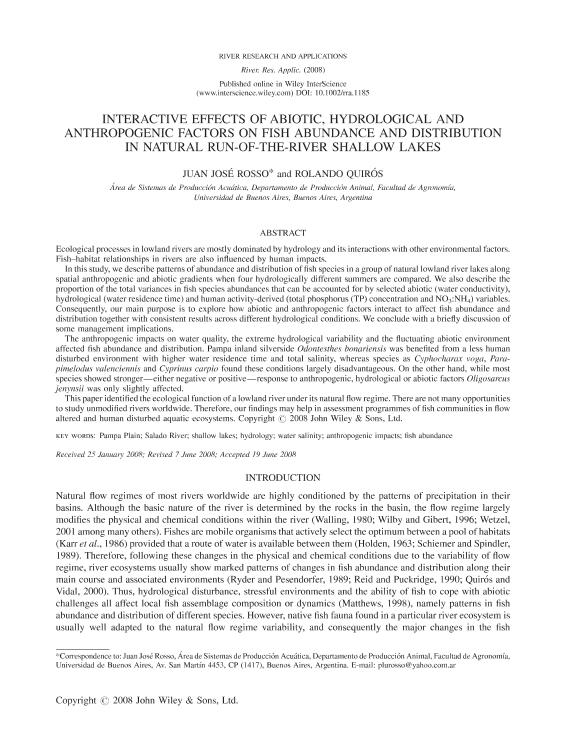Mostrar el registro sencillo del ítem
dc.contributor.author
Rosso, Juan Jose

dc.contributor.author
Quirós, Rolando
dc.date.available
2020-08-21T20:49:23Z
dc.date.issued
2009-07
dc.identifier.citation
Rosso, Juan Jose; Quirós, Rolando; Interactive effects of abiotic, hydrological and anthropogenic factors on fish abundance and distribution in natural run-of-the-river shallow lakes; John Wiley & Sons Ltd; River Research And Applications; 25; 6; 7-2009; 713-733
dc.identifier.issn
1535-1459
dc.identifier.uri
http://hdl.handle.net/11336/112193
dc.description.abstract
Ecological processes in lowland rivers are mostly dominated by hydrology and its interactions with other environmental factors. Fish–habitat relationships in rivers are also influenced by human impacts. In this study, we describe patterns of abundance and distribution of fish species in a group of natural lowland river lakes along spatial anthropogenic and abiotic gradients when four hydrologically different summers are compared. We also describe the proportion of the total variances in fish species abundances that can be accounted for by selected abiotic (water conductivity), hydrological (water residence time) and human activity‐derived (total phosphorus (TP) concentration and NO3:NH4) variables. Consequently, our main purpose is to explore how abiotic and anthropogenic factors interact to affect fish abundance and distribution together with consistent results across different hydrological conditions. We conclude with a briefly discussion of some management implications. The anthropogenic impacts on water quality, the extreme hydrological variability and the fluctuating abiotic environment affected fish abundance and distribution. Pampa inland silverside Odontesthes bonariensis was benefited from a less human disturbed environment with higher water residence time and total salinity, whereas species as Cyphocharax voga, Parapimelodus valenciennis and Cyprinus carpio found these conditions largely disadvantageous. On the other hand, while most species showed stronger—either negative or positive—response to anthropogenic, hydrological or abiotic factors Oligosarcus jenynsii was only slightly affected. This paper identified the ecological function of a lowland river under its natural flow regime. There are not many opportunities to study unmodified rivers worldwide. Therefore, our findings may help in assessment programmes of fish communities in flow altered and human disturbed aquatic ecosystems.
dc.format
application/pdf
dc.language.iso
eng
dc.publisher
John Wiley & Sons Ltd

dc.rights
info:eu-repo/semantics/openAccess
dc.rights.uri
https://creativecommons.org/licenses/by-nc-sa/2.5/ar/
dc.subject.classification
Ciencias Medioambientales

dc.subject.classification
Ciencias de la Tierra y relacionadas con el Medio Ambiente

dc.subject.classification
CIENCIAS NATURALES Y EXACTAS

dc.title
Interactive effects of abiotic, hydrological and anthropogenic factors on fish abundance and distribution in natural run-of-the-river shallow lakes
dc.type
info:eu-repo/semantics/article
dc.type
info:ar-repo/semantics/artículo
dc.type
info:eu-repo/semantics/publishedVersion
dc.date.updated
2020-05-11T18:21:00Z
dc.journal.volume
25
dc.journal.number
6
dc.journal.pagination
713-733
dc.journal.pais
Reino Unido

dc.journal.ciudad
Londres
dc.description.fil
Fil: Rosso, Juan Jose. Universidad de Buenos Aires. Facultad de Agronomía. Departamento de Producción Animal. Cátedra de Sistemas de Producción Acuática; Argentina. Consejo Nacional de Investigaciones Científicas y Técnicas. Oficina de Coordinación Administrativa Parque Centenario; Argentina
dc.description.fil
Fil: Quirós, Rolando. Universidad de Buenos Aires. Facultad de Agronomía. Departamento de Producción Animal. Cátedra de Sistemas de Producción Acuática; Argentina
dc.journal.title
River Research And Applications

dc.relation.alternativeid
info:eu-repo/semantics/altIdentifier/url/https://onlinelibrary.wiley.com/doi/abs/10.1002/rra.1185
dc.relation.alternativeid
info:eu-repo/semantics/altIdentifier/doi/https://doi.org/10.1002/rra.1185
Archivos asociados
